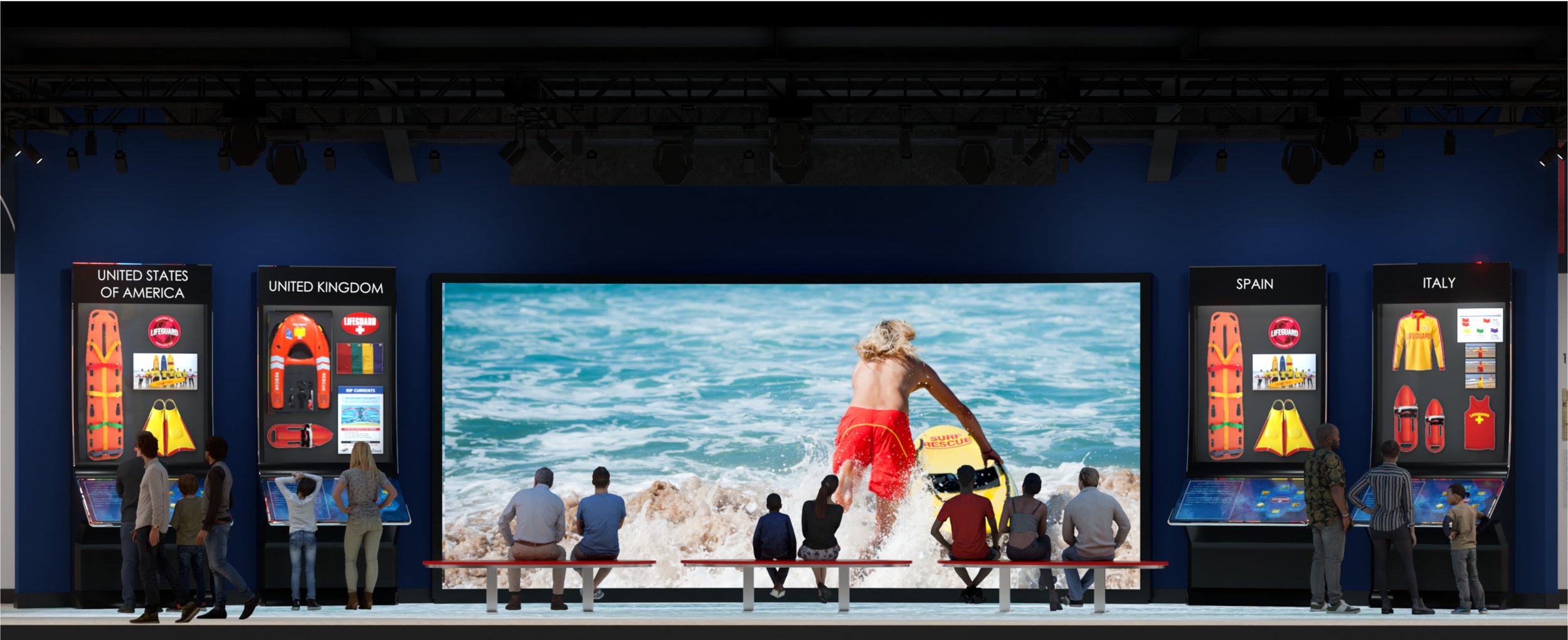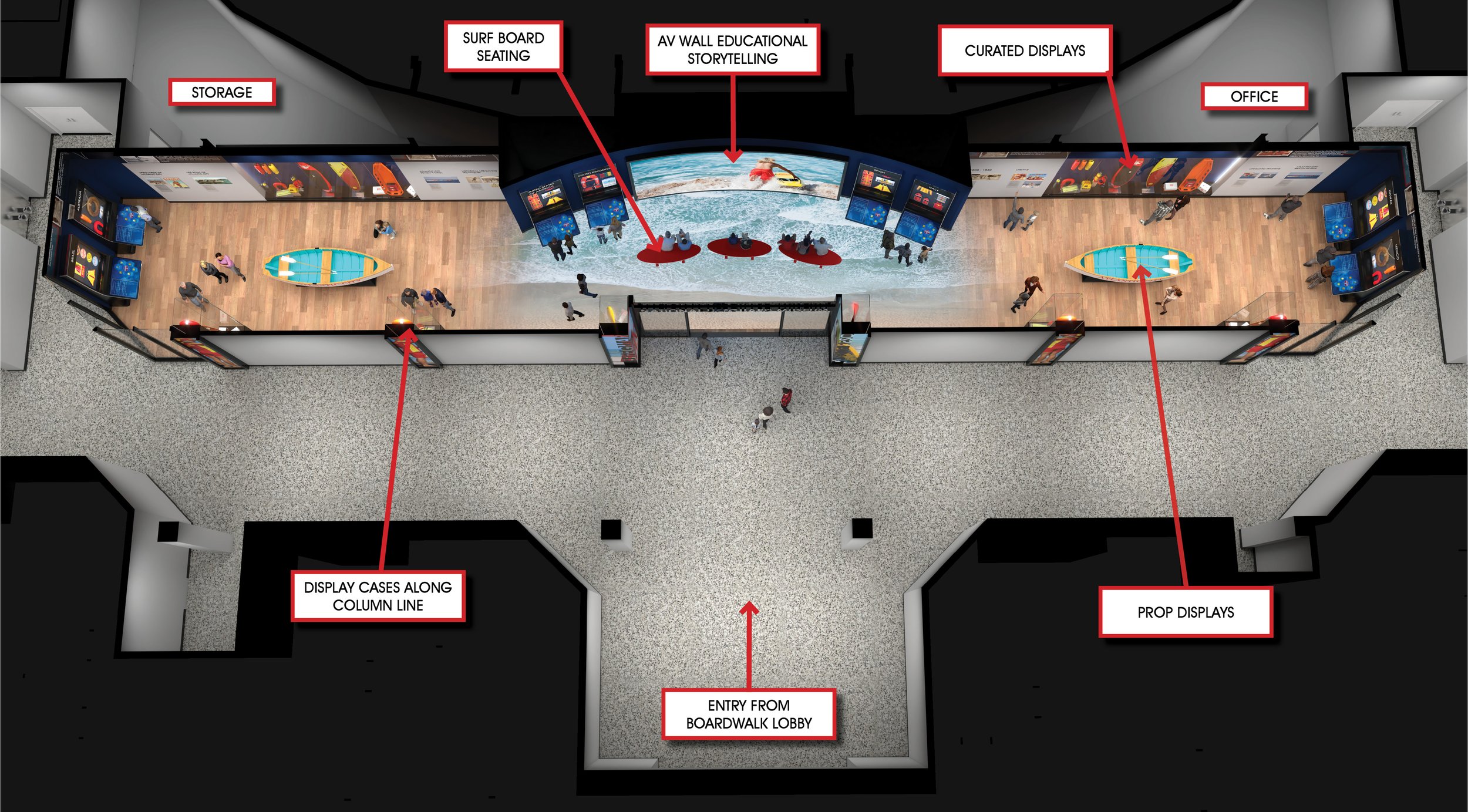
The Museum
Established in 1855, the Atlantic City Beach Patrol is the oldest operational lifeguard organization in the United States, making Atlantic City an ideal home for the Museum. Thanks to a generous grant from the Casino Reinvestment Development Authority (CRDA), the Museum will be located in the Jim Whelan Boardwalk Hall, a fitting tribute to its namesake.
While the location and origins of the Museum are deeply rooted in local history, the commonality of the cause and significance of lifeguarding extend far beyond our shores. This makes sharing stories, images, and experiences from around the world not only crucial but also a natural choice for the Museum’s international focus.

How it will celebrate
Lifeguarding is a competitive sport that tests the physical and mental skills needed to save lives in the aquatic environment.
Competitions are held on local levels, as well as international ones with the objectives to uplift guard morale, stimulate personal interest in rescue skill training, and acquaint the general public with water safety procedures and skills used daily by professional lifeguards to advance public safety.
The sport is not simply about the physicality of these elite athletes but of their ability to adapt, prioritize, and innovate.
The Museum aims to celebrate the guardians of our waters through an ethereal realm of innovative space where design and emotions intertwine to craft a captivating narrative. Each curated key moment represents the heroic acts of lifeguards showcasing their courageous rescues, unwavering vigilance, and steadfast dedication as essential first responders.
Through virtual and physical displays, visitors will be granted an opportunity to be part of the profound connection that bonds lifeguards around the world to a commonality that transcends all borders.
How it will educate
The vision for the International Lifeguard Museum centers on the urgent need for water safety education, aiming to reshape how visitors understand the dangers of oceans and other bodies of water. This immersive museum will provide unique experiences that educate and emotionally resonate, emphasizing the critical importance of learning to swim and understanding water safety.
Each year, around 4,000 people drown in the United States, translating to 11 fatalities daily (National Center for Health Statistics, 2000). Drowning is the third leading cause of unintentional injury death globally, with children and young adults aged 1-24 being especially vulnerable (World Health Organization).
Visitors will engage with interactive exhibits showcasing real-life rescue scenarios and the evolution of lifeguarding, including the history of the Atlantic City Beach Patrol since 1855. Major aquatic safety organizations emphasize prevention through education, highlighting that while lifeguards perform over 100,000 rescues annually, ongoing training has helped maintain stable drowning rates at lifeguarded beaches (U.S. Lifesaving Associations, 2000)
By sharing these impactful stories and statistics, the International Lifeguard Museum aims to inspire visitors to value life-saving skills related to swimming and water safety. This educational environment will empower individuals with knowledge, fostering a culture of safety and reducing drowning incidents.
Together, we can ensure that every visit to the water is not only enjoyable but safe.
Examples of Exhibits
-
In a heartwarming celebration, Chris Lewis, a 74-year-old lifeguard from Bournemouth, was recognized by Guinness World Records as the longest-serving lifeguard in the world. His remarkable journey reflects decades of commitment to saving lives along the shores of the UK and Channel Islands.
Every day, Lewis faces the demanding responsibilities of a lifeguard, demonstrating exceptional fitness and resilience. Last year alone, he and his Royal National Lifeboat Institution (RNLI) team saved 86 lives, highlighting the courage of their mission.
One rescue stands out: in 2010, he bravely saved three children from turbulent waters, a moment that showcased both the fear and determination inherent in his role. The crowd's applause upon their safe return underscored the profound impact he has had on his community.
Chris Lewis embodies true heroism, illustrating that strength lies in compassion and a steadfast commitment to making a difference, one life at a time.
Source: Guinness World Records
-
Nothing forges a bond like the responsibility of ensuring safety and saving lives. Lifeguards come from diverse backgrounds, yet their shared mission creates a deep connection. The rigorous training and long hours spent together by the water cultivate trust and teamwork.
In the video featuring the Bondi Lifeguards, a powerful theme of brotherhood emerges, illustrating how their experiences form unbreakable ties. They navigate challenges on the iconic shores of Bondi Beach, becoming more than colleagues—they are a tightly-knit family.
Each lifeguard shares personal stories of adrenaline-filled rescues and moments of peril, highlighting the unwavering support they provide one another. Whether it's the reassurance of a teammate during a rescue or shared laughter to lighten the load, these moments foster profound camaraderie.
Ultimately, the video captures the essence of the Bondi Lifeguards: a brotherhood built on trust, resilience, and shared purpose. Together, they remind us that they are not only stronger but truly unstoppable.
-
Lifeguarding demands extraordinary physical and mental strength, a reality brought to life at the United States Lifesaving Association (USLA) National Lifeguard Championships. Held annually in August, this thrilling event showcases the athletic prowess of around 1,000 competitors, including dedicated lifeguards and junior lifeguards, all eager to prove their skills.
Since 1980, the championships have become a vibrant display of strength and endurance, with events designed to challenge lifeguards in scenarios that simulate real-life rescues. Competitors tackle grueling tasks—racing against the clock in ocean swims, sprinting up the beach with rescue equipment, and executing precise rescue techniques under pressure. Each event tests their physical limits, showcasing not only their speed and agility but also their ability to think on their feet in high-stakes situations.
The energy of the competition is palpable, fueled by the camaraderie and support from coaches, families, and friends. As athletes push their bodies to the brink, they demonstrate remarkable athleticism and resilience, embodying the spirit of teamwork that defines the lifeguarding community.
These championships are a powerful reminder of what it takes to be a lifeguard—strength, determination, and an unwavering commitment to saving lives. In this arena, competitors don’t just strive for victory; they honor the shared values of bravery and dedication that bind them together, showcasing the best of what it means to be a lifeguard.
Source: United States Lifesaving Association.


